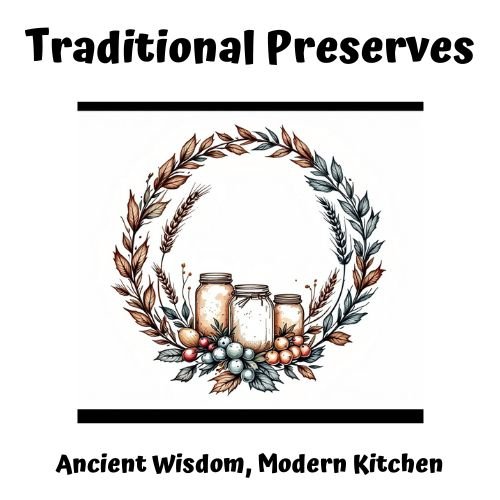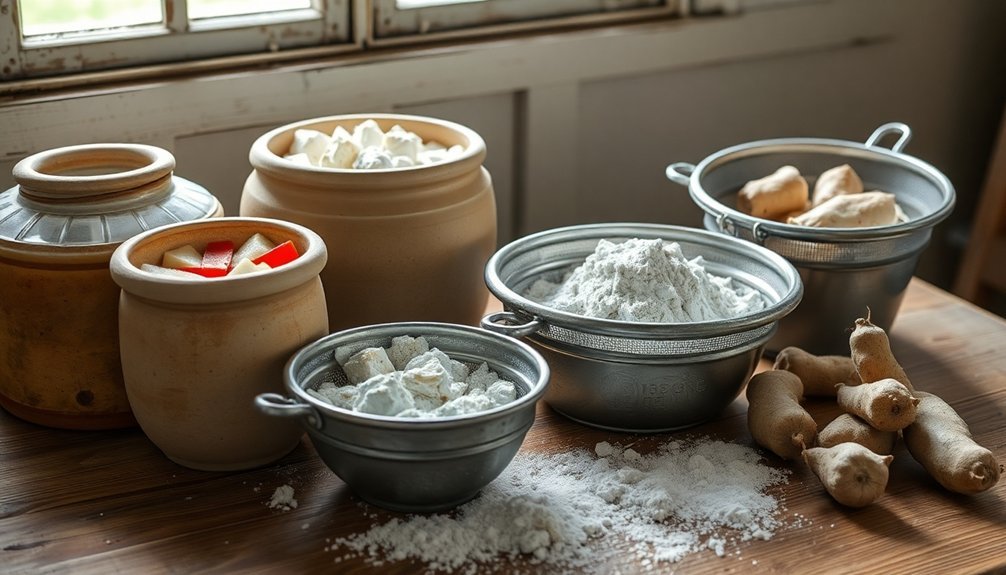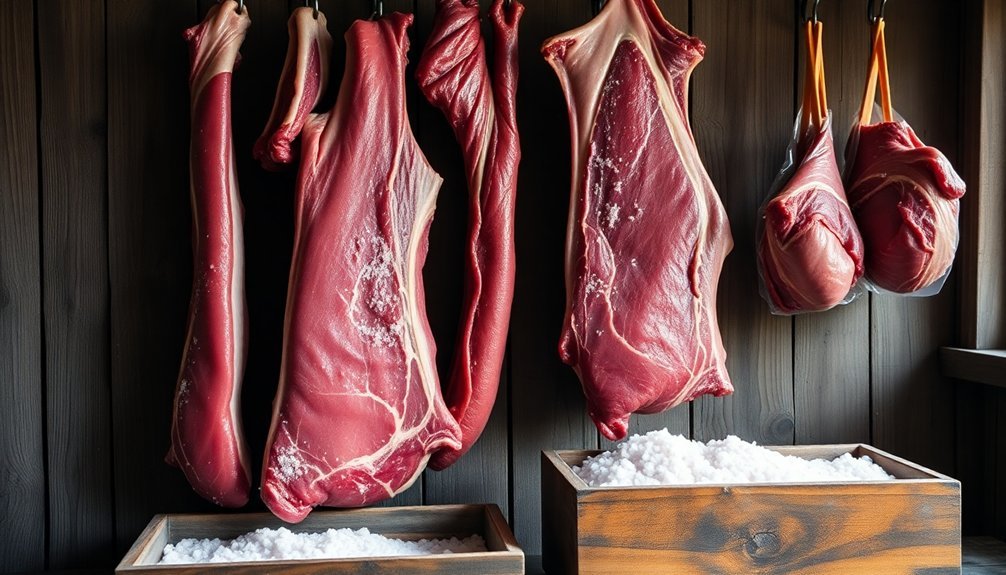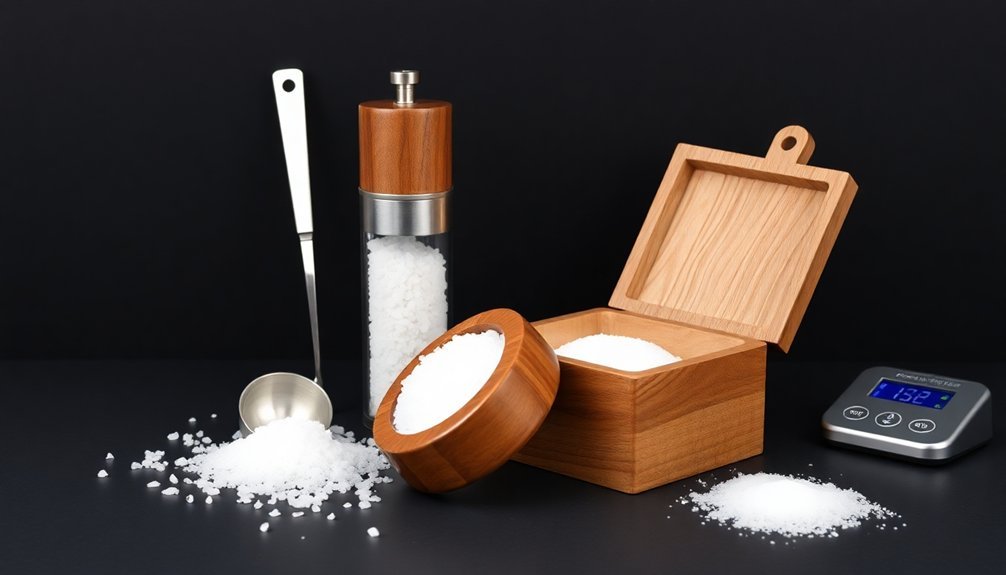Ash preservation is an ancient food storage technique that you'll find deeply rooted in Native American, Asian, and European cultures. Using hardwood ash from sources like hickory and oak, you can preserve meats, hard cheeses, and firm vegetables for months or even years. You'll need basic tools like stoneware crocks, fine-mesh sieves, and airtight containers to get started. The key is proper layering – completely surrounding your food with dried, sifted ash while avoiding air pockets. It's crucial to maintain cool, dark storage conditions and monitor regularly for spoilage. This age-old method offers just one glimpse into our ancestors' ingenious food preservation practices.
Ancient Origins of Ash Preservation

You'll find that the timeline of ash's shift from soap-making to food preservation remains somewhat mysterious, as direct historical records are scarce.
However, the widespread availability of ashes in ancient cultures led to diverse applications across different regions. Ancient civilizations discovered that chemical compounds in ashes could effectively protect food from spoilage.
When you look at traditional recipes that have survived through generations, you'll notice lye's vital role in preserving foods like Norwegian lutherfisk, German pretzels, and Mediterranean olives.
The practice became particularly valuable in humid climates where traditional drying methods proved ineffective.
This preservation technique eventually spread globally, influencing various culinary traditions from Chinese moon cakes to South American hominy.
Cherokee Wisdom and Practices
You'll find the Cherokee's use of hickory ash particularly fascinating, as they masterfully preserved meat by surrounding it with sifted ash in stoneware crocks and earthenware vessels.
This preservation method was highly effective, as food in ash could extend preservation time from 3 months to several years.
Their storage techniques involved keeping preserved foods separate from each other in cool, dark locations, often utilizing underground storage to take advantage of natural temperature control.
This preservation knowledge, passed down through generations, demonstrates the Cherokee's deep understanding of food storage methods that worked harmoniously with available natural resources.
Hickory Ash Meat Methods
Through centuries of practice, the Cherokee people developed sophisticated meat preservation techniques using hickory ash, a method that combined both practical preservation and distinctive flavoring. You'll find that this method starts with careful meat selection, typically pork cuts like hams or bellies, followed by thorough cleaning and precise trimming. Traditional smokehouses would use dead fruit trees for optimal meat flavoring.
| Process Step | Duration | Temperature |
|---|---|---|
| Initial Salting | 6 weeks | 32-40°F |
| Ash Coating | 1-2 days | Room temp |
| Curing | 7 days/inch | 32-40°F |
| Smoking | 10+ days | Below 142°F |
| Final Drying | 30+ days | Cool temps |
To preserve your meat, you'll need to first rub it thoroughly with coarse salt, then coat it with hickory ashes to deter insects and enhance flavor. During the curing phase, you'll want to maintain temperatures between 32° and 40°F. The smoking process requires hardwoods like hickory, apple, or oak, with smoke released steadily at cooler temperatures for at least 10 days. Once smoked, you'll hang the meat high in the rafters for further drying, ensuring it stays preserved through the winter months when fresh meat was traditionally scarce.
Traditional Storage Techniques
Traditional Cherokee storage techniques relied heavily on the ingenious use of wood ash, particularly from hickory and oak trees, to preserve a variety of foods throughout the year.
To use this method effectively, you'll need to start by sifting your wood ash to remove any large pieces, ensuring a fine, consistent material for preservation.
You can store your food items in stoneware crocks or earthenware containers, making sure to maintain a layer of ash that's 1 to 1.5 inches thick around the food.
When packing your items, it's essential to keep them from touching each other and to completely surround them with ash. You'll want to cover your containers with stoneware lids or plates to maintain the preservation environment.
For best results, you'll need to store your ash-packed containers in a cool, dark location like a cellar.
This method works particularly well for hard cheeses, which can stay fresh for up to three months while developing an enhanced flavor profile. The ash creates a protective rind around the cheese that you can easily remove before consumption.
Throughout storage, the ash acts as both a preservative and a natural pest deterrent.
Cultural Preservation Knowledge
Cherokee wisdom surrounding food preparation reflects a deep understanding of both nutrition and environmental stewardship. The use of wood ash lye in nixtamalization demonstrates their sophisticated knowledge of food science, making corn more nutritious and digestible.
You'll find this practice was adopted from Mesoamerican tribes, showing how traditional knowledge spread across cultures.
When you're learning about Cherokee food preservation, you'll discover these essential practices:
- The preparation of kanuchi balls from hickory nuts, traditionally stored in wood barrels or stone pots for winter use.
- The careful processing of white oak acorns through crushing and shelling to create nutritious meal for bread making.
- The intentional drying of persimmons, berries, and other wild fruits to extend their availability through winter.
- The communal approach to food preparation, as seen in corn-husking feasts that combined work with celebration.
You'll notice these methods weren't just about survival – they reflected a deep respect for the earth's resources.
The Cherokee's seasonal approach to gathering and preserving food demonstrates their understanding of natural cycles and sustainable living practices, something that's increasingly relevant today.
Essential Tools and Materials

Successfully preserving food throughout history required specific tools and materials that were carefully chosen for their effectiveness.
You'll need appropriate storage containers, including wooden boxes, woven baskets, or earthenware crockery. For added protection, you can line cardboard boxes with paper to create a more suitable storage environment.
Your ash preparation tools should include fine-mesh sieves for removing sharp particles and debris. You'll want to sift the ash multiple times to achieve the finest possible texture, using only cool ash from cooking fires.
When selecting food items, particularly tomatoes and hard cheeses, choose those that are ripe but firm, free from blemishes and bruising.
For proper storage conditions, you'll need containers that can maintain darkness and limit air exposure. You should use loose-fitting covers to keep the ash undisturbed while allowing minimal airflow.
If you're dealing with temperature fluctuations, you can partially bury your containers in soil. The key is maintaining a cool, dry environment throughout the preservation process.
Remember to handle all materials gently to prevent damage to both the food and storage containers.
Types of Wood Ash
When choosing wood ash for food preservation, you'll find that hickory ash stands out as the most historically proven option, particularly in Native American traditions for preserving meat.
While modern sources might include commercially available wood ash, you're better off using traditional hardwoods like hickory and white ash rather than processed lumber or treated wood.
You'll need to avoid ash from toxic woods like oleander or pressure-treated lumber, as these can contaminate your preserved foods with harmful chemicals.
Best Woods for Preservation
Throughout history, wood ash has played an essential role in food preservation, with specific types of wood proving more effective than others. If you're looking to preserve food using traditional methods, choosing the right wood ash can make a significant difference in your results.
- Hickory ash stands out as a premier choice, particularly for meat preservation. The Cherokee people have long used it for its unique chemical composition that protects food from air exposure and pests while adding distinctive flavor.
- Oak ash offers high alkalinity levels, making it excellent for preserving cheese in stoneware crocks. It's also traditionally used in making lye hominy and can be combined with other preservation methods.
- When using general wood ash from fire pits or wood stoves, you'll need to verify it's thoroughly dried and properly sifted to remove any sharp particles or large bits that could contaminate your food.
- Whatever type you choose, store your preserved foods in airtight containers kept in cool, dark places. You can even reuse the ash later as garden fertilizer once you're done with preservation.
Remember to sift all wood ash before use and verify it's free from contaminants for ideal preservation results.
Traditional Vs Modern Sources
Understanding the differences between traditional and modern sources of wood ash can greatly impact your food preservation results. Historically, wood ash served multiple purposes, from producing potash to preserving various foods like meat, eggs, cheese, and vegetables.
Traditional societies, including the Cherokee people, used specific woods like hickory for preservation, while African farmers preserved tomatoes using locally sourced ash.
Today, you'll likely collect ash from backyard fire pits or wood stoves rather than traditional communal sources. While the basic preservation principles remain the same, you'll need to be more cautious about your ash sources.
Only use ash from hardwoods like maple or oak, and avoid any wood that's been pressure-treated or exposed to chemicals. You'll want to verify your ash is completely dry and properly sifted to remove larger pieces.
Whether you're using traditional earthenware crocks or modern stoneware containers, the storage methods haven't changed notably. You'll still need to maintain cool, dark conditions and protect your preserved foods from air exposure.
The key is selecting clean, uncontaminated ash sources while following time-tested preservation methods.
Safe Vs Toxic Ash
The safety of your wood ash directly determines the success of food preservation. When selecting wood for your ash, you'll want to focus on hardwoods like maple, oak, and hickory, as they produce safer, more effective ash.
Fruit tree wood is also acceptable, but you should always avoid chemically treated lumber or wood that's been exposed to pesticides.
Before using ash for preservation, verify it's properly prepared and stored. Sift it through fine mesh to remove debris and sharp particles, and keep it in a cool, dry place using earthenware or stoneware containers.
Here's what you must avoid when sourcing ash for food preservation:
- Ash from pressure-treated lumber or chemically treated wood, which can introduce toxins into your preserved foods
- Ash from burned plastics or synthetic materials, which produce harmful compounds
- High-temperature ash that may have altered chemical properties and reduced effectiveness
- Contaminated ash that's been exposed to soil, water, or environmental pollutants
Proper Storage Conditions

In accordance with historical food preservation methods, proper storage conditions play an essential role in maintaining the quality and longevity of ash-preserved foods. You'll need to select a cool, dry location away from direct sunlight and high temperatures, such as a basement or cellar, to create an ideal preservation environment.
When choosing containers, opt for wooden boxes, earthenware crockery, or woven baskets, as they provide better insulation and protection. Don't use plastic containers, as they can trap moisture and promote decay. Make sure your containers are clean and free from contaminants before use.
To maintain proper storage conditions, you'll want to keep your containers sealed but not completely airtight, allowing minimal air circulation while preventing moisture buildup. It's important to monitor your stored items regularly, checking for any signs of spoilage or pest infestation.
Make sure the ash layers remain intact and evenly distributed around the food. Remember to maintain consistent temperature and humidity levels in your storage area. If you notice any changes in the preservation environment or signs of food deterioration, take immediate corrective action to protect your preserved goods.
Step-by-Step Preservation Method
You'll want to start by selecting a breathable stoneware container and placing your clean, dry food items inside with at least 1-1.5 inches of space around each piece.
Next, carefully sift your hardwood ash to remove any debris, and layer it around your food items, making sure there's no direct contact between pieces or with the container walls.
Finally, fill all remaining gaps with the sifted ash until your food is completely surrounded, ensuring no air pockets remain that could compromise the preservation process.
Basic Storage Setup Steps
Setting up a proper storage system for wood ash preservation requires careful attention to four key steps: selecting appropriate ash, preparing the container, placing food correctly, and maintaining ideal storage conditions.
To guarantee success with this time-tested preservation method, you'll want to follow these essential steps carefully.
1. Start by gathering hardwood ash from sources like hickory, making sure it's completely cool and sifted to remove any large particles.
Don't use softwood or treated wood ash, as they can contain harmful chemicals.
2. Choose a stoneware or earthenware container with a lid, confirming it's clean and dry.
While you can use alternatives like cardboard boxes, stoneware provides the best protection and most consistent environment.
3. Place your food items in the container's center, maintaining a 1 to 1.5-inch buffer of ash on all sides.
Make sure items don't touch each other or the container walls, and cover completely with ash.
4. Store your container in a cool, dark place like a cellar, checking periodically for any signs of spoilage.
The location should be pest-free, though the ash itself helps deter unwanted visitors.
Layering Techniques For Success
Proper layering stands at the heart of successful wood ash preservation, requiring careful attention to detail and methodical placement of both food and ash.
You'll need to start with a stoneware pot or earthenware crockery as your preservation vessel. For cheese, confirm your selected piece is roughly 1.5 inches thick for best results.
Begin by sifting your wood ash to achieve a fine, consistent texture. You'll want to create a base layer of ash before placing your food item. Pack a 1 to 1.5-inch layer of ash around your cheese, making sure there aren't any air pockets.
If you're preserving eggs, tomatoes, or other produce, follow the same principle of complete ash coverage.
For meat preservation, opt for hickory ash, which serves the dual purpose of flavoring and preserving. Whatever food you're preserving, confirm you're filling all gaps between items with ash to maintain a sealed environment.
The key to successful layering lies in creating an airtight seal that prevents exposure to air and moisture. Remember to store your preserved items in a cool, dark place like a cellar to maximize their preservation time.
Foods Best Suited

The art of food preservation using wood ash requires selecting items with specific characteristics that make them ideal candidates for this ancient method. Foods that work best with this preservation technique share qualities like durability, proper moisture content, and the ability to withstand direct contact with ash without deteriorating.
- Hard cheeses are excellent choices, particularly varieties like Gruyere. You'll want pieces about 4 inches square and 1.5 inches thick, but be prepared to remove the outer rind that forms during preservation.
- Eggs can be preserved by rolling them in sifted ash after boiling. You'll notice the whites shrink while the yolks maintain their texture, creating a stable preserved food that doesn't require refrigeration.
- Tomatoes store remarkably well when layered upside down in ash. Choose firm, ripe specimens without blemishes, and you can keep them through winter months while maintaining their juicy pulp.
- Meat preservation works especially well with hickory ash, which not only preserves but also adds flavor. The Cherokee people's traditional use of this method proves its effectiveness, particularly when stored in cool, dark conditions.
Cultural Significance Through Time
Beyond selecting ideal foods for ash preservation, understanding this method's rich cultural heritage reveals its profound impact across civilizations. You'll find ash preservation deeply woven into ancient societies, from Mesoamerican nixtamalization techniques to Roman wine clarification processes. In fact, you're witnessing a practice that's shaped human cuisine for millennia.
The cultural significance extends far beyond mere preservation. When you look at traditional Portuguese "pão de soborralho" or alkaline noodles in Asian cuisines, you'll see how ash-based techniques have become integral to cultural identity. These methods don't just preserve food – they transform it, creating unique textures and flavors that define regional cuisines.
You'll discover ash's importance in religious and symbolic practices too, where it's often associated with renewal and transformation. Even today, Native American communities continue these traditional practices, proving ash preservation isn't just history – it's living culture.
From haute cuisine to traditional cooking, you'll find modern chefs incorporating these ancient techniques, bridging past and present. The method's versatility in food preparation and preservation has guaranteed its place in both traditional and contemporary cooking practices.
Common Mistakes to Avoid

Successful ash preservation demands attention to detail, and even small oversights can lead to spoiled food or safety concerns. When preserving food with ash, you'll need to be mindful of several critical factors to guarantee your efforts don't go to waste.
- Choose the right ash source – Don't use charcoal or treated wood ash. Instead, opt for ash from chimneys or cooking fires, and make sure it's completely cooled and properly sifted to remove debris.
- Prepare your food carefully – Select only firm, ripe tomatoes without blemishes, and guarantee all ingredients are thoroughly dried before preservation. Avoid using soft cheeses or foods with high moisture content.
- Create proper storage conditions – Store your preserved foods in a cool, dark place using appropriate containers like cardboard boxes or earthenware. Don't use plastic wrap or containers that trap moisture.
- Layer and seal correctly – Arrange food in a single layer, ensuring complete ash coverage without excessive thickness. Use a loose-fitting cover that allows minimal air circulation while keeping the ash undisturbed.
Safety Measures and Precautions
Safe food preservation using wood ash requires strict adherence to multiple safety protocols that protect both your health and the quality of preserved foods.
When handling wood ash, you'll need to wear a protective mask to prevent inhaling particles and cover your skin to avoid irritation. After handling ash, wash exposed areas thoroughly with water.
You'll want to use only hardwood ash from sources like maple or oak, and never use ash from pressure-treated lumber, plastics, or hazardous materials.
Keep your storage location cool and dark, and maintain distance from water sources to prevent contamination. Don't store food during heavy rainfall or storms.
For proper food preservation, you'll need to use appropriate containers like earthenware crockery.
Remove plastic wrap from food items, and guarantee they don't touch each other when stored.
Sift the ash to remove larger pieces, and seal containers properly with lids or weighted plates.
Check that your ash is completely free from hot coals, which pose both fire and health risks.
Keep your storage area clean and pest-free, and don't track ash into your living spaces to maintain indoor cleanliness.
Modern Applications and Adaptations

While traditional safety protocols remain fundamental, modern food preservation with wood ash has adapted to incorporate new materials and methods.
You'll find that contemporary approaches combine time-tested techniques with newer storage solutions, making this preservation method more accessible than ever.
Today's wood ash preservation incorporates various containers, from traditional stoneware to modern alternatives.
You can effectively store your preserved foods in earthenware crockery or even carefully prepared cardboard boxes, provided you maintain proper coverage and separation of items.
- Choose from multiple container options: stoneware pots for cheese and eggs, earthenware crocks for vegetables, or cardboard boxes for temporary storage
- Combine preservation methods: pair wood ash with smoking, salting, or dehydration for enhanced results
- Store in modern environments: utilize temperature-controlled cellars or cool basements to maintain ideal conditions
- Take advantage of versatility: preserve everything from hard cheeses to tomatoes, adapting traditional techniques to your needs
The lightweight nature and pest-deterrent properties of wood ash make it particularly practical for modern food storage, while its cost-effectiveness and availability continue to make it an attractive option for contemporary food preservation.
Alternative Storage Methods
Traditional food preservation extends far beyond wood ash storage, offering you a diverse range of methods that have stood the test of time. While wood ash creates a protective barrier against pests and microorganisms, you'll find other effective techniques that work through different mechanisms.
Consider dehydrating and drying, which remove moisture to prevent spoilage, unlike wood ash's physical barrier approach. You can also explore fermentation and salting, which alter food's pH levels and moisture content to create inhospitable environments for harmful bacteria.
If you're interested in more complex methods, smoking and curing provide preservation through chemical changes and antimicrobial compounds. For modern convenience, you might prefer canning and bottling, though these require specific equipment and careful attention to temperature control.
Lacto-fermentation offers another alternative, creating an acidic environment that naturally preserves food. When choosing between these methods, consider your storage conditions – you'll need cool, dark spaces for most preservation techniques, and you'll want to account for your local altitude, which can affect processing times.
Each method has its unique advantages, allowing you to select the most suitable approach for your specific needs.
Frequently Asked Questions
Can Wood Ash Preservation Affect the Taste of Preserved Eggs?
You'll notice a slight change in taste when using wood ash preservation for eggs, but it's milder than other methods. The ash won't absorb into the shell, so it won't greatly alter your eggs' flavor.
How Long Should Ash Be Allowed to Cool Before Use?
You'll need to let your ashes cool for at least 96 hours (four days) in a metal container. Don't rush this process – it's crucial to double-check for any remaining hot spots before use.
Is It Possible to Mix Different Types of Wood Ash Together?
Yes, you can mix different types of wood ash together, but be sure they're all from untreated wood. Avoid mixing in ash from painted, pressure-treated, or garbage wood to prevent contamination.
What Signs Indicate That Ash-Preserved Food Has Gone Bad?
You'll know your ash-preserved food has spoiled if you notice any mold growth, foul odors, unnatural colors, sliminess, or visible ash contamination. Never consume food showing these warning signs.
Can Commercial Fireplace Ash Be Used for Food Preservation?
Yes, you can use commercial fireplace ash from hardwoods like hickory, oak, or elm for food preservation. Make sure it's cooled, sifted, and free of contaminants. Don't use ash from softwoods or treated woods.
In Summary
Whether you're a homesteader or history enthusiast, ash preservation offers a time-tested method to extend your food's shelf life. By following proper safety measures and selecting the right wood ash, you'll join countless generations who've relied on this ancient technique. Don't let this traditional wisdom fade away – start experimenting with ash preservation today, and you'll add a valuable skill to your food storage knowledge.





Leave a Reply